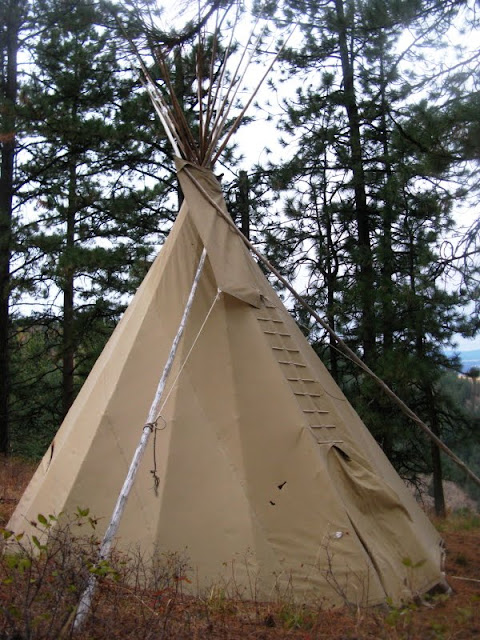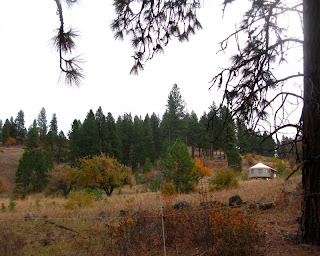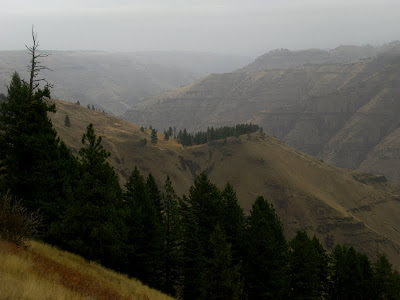 After leaving Multnomah Falls, I tootled eastward along I-84, minding my own business for about four hours, until I came upon a sight that made me realize I was coming in to the north country. Never mind that I was, by then, heading southeast. Traveling west to east along the Columbia River doesn't make me think "north" - though coming to the river from the south might indeed make me think that. The yellow-green to yellow-orange trees I saw on the hillside made me think north, and they always do. These trees are conifers, commonly known as western larch (Larix occidentalis), sometimes called deciduous because they lose their needles every year. They are like little flames on the hillsides in the fall, when their needles turn yellow-green, then yellow, and then orange.
After leaving Multnomah Falls, I tootled eastward along I-84, minding my own business for about four hours, until I came upon a sight that made me realize I was coming in to the north country. Never mind that I was, by then, heading southeast. Traveling west to east along the Columbia River doesn't make me think "north" - though coming to the river from the south might indeed make me think that. The yellow-green to yellow-orange trees I saw on the hillside made me think north, and they always do. These trees are conifers, commonly known as western larch (Larix occidentalis), sometimes called deciduous because they lose their needles every year. They are like little flames on the hillsides in the fall, when their needles turn yellow-green, then yellow, and then orange. After a long drive across paved roads leading to graveled roads leading finally - after dark - to a rocky "rough dirt track," I came to the home of Liz Enslin, who lives in a yurt and blogs at Yips and Howls. [Photo taken inside the guest teepee.]
After a long drive across paved roads leading to graveled roads leading finally - after dark - to a rocky "rough dirt track," I came to the home of Liz Enslin, who lives in a yurt and blogs at Yips and Howls. [Photo taken inside the guest teepee.] I was treated to great hospitality by Liz and her partner Jerry. The hospitality included a salad from homegrown vegetables and a great local beer: Terminal Gravity IPA brewed by the Terminal Gravity Brewery in Enterprise, Oregon . After enjoying bloggish conversation, I was escorted to the guest teepee.
I was treated to great hospitality by Liz and her partner Jerry. The hospitality included a salad from homegrown vegetables and a great local beer: Terminal Gravity IPA brewed by the Terminal Gravity Brewery in Enterprise, Oregon . After enjoying bloggish conversation, I was escorted to the guest teepee. In the morning, I awoke to this great view of the canyonlands of northeastern Oregon.
In the morning, I awoke to this great view of the canyonlands of northeastern Oregon. This is the teepee that was my overnight home. I was told by my hosts, after morning coffee, that the holes in the teepee canvas were put there by the slashing claws of a black bear. I didn't hear anything terribly suspicious in the dark of the night, but did hear coyotes in the early morning.
This is the teepee that was my overnight home. I was told by my hosts, after morning coffee, that the holes in the teepee canvas were put there by the slashing claws of a black bear. I didn't hear anything terribly suspicious in the dark of the night, but did hear coyotes in the early morning.
The yurt, as seen from the teepee. More about yurt living at Yips and Howls.
 The countryside is underlain by basalt flows, like these barely seen under cloudy skies. These flows are part of the same Grand Ronde Basalt (CRBG) that we saw at Multnomah Falls.
The countryside is underlain by basalt flows, like these barely seen under cloudy skies. These flows are part of the same Grand Ronde Basalt (CRBG) that we saw at Multnomah Falls. Flows of the Grand Ronde Basalt are well exposed in Joseph Canyon at the Joseph Canyon Viewpoint on Highway 3. The basalt flows erupted from long fissure vents in this part of northeast Oregon and in southeast Washington; the resulting dike system is sometimes known as the Chief Joseph Dike Swarm. I took a few pictures in the pouring rain, did not see any dikes, and moved on.
Flows of the Grand Ronde Basalt are well exposed in Joseph Canyon at the Joseph Canyon Viewpoint on Highway 3. The basalt flows erupted from long fissure vents in this part of northeast Oregon and in southeast Washington; the resulting dike system is sometimes known as the Chief Joseph Dike Swarm. I took a few pictures in the pouring rain, did not see any dikes, and moved on. Yes, the larch were turning yellow!
Yes, the larch were turning yellow! I first saw larch in west-central Idaho, probably not much farther north than these trees are located.
I first saw larch in west-central Idaho, probably not much farther north than these trees are located. It was spring, and the new feathery needles were on the trees. I was amazed to "discover" such an unusual tree, and I'm still amazed every time I see them. Larches remind me of that first trip north of Boise a long time ago, and they remind me of every trip I've taken on the Alcan since then.
It was spring, and the new feathery needles were on the trees. I was amazed to "discover" such an unusual tree, and I'm still amazed every time I see them. Larches remind me of that first trip north of Boise a long time ago, and they remind me of every trip I've taken on the Alcan since then.Some Links:
Liz Enslin has more about larch, as part of her Species of the Week series.
General Overview of the Columbia River Basalt Province (with photo of a dike in the Chief Joseph dike swarm).
Photo Tour of the Columbia River Basalt Province (with photos of the Grand Ronde Basalt and some cross-cutting dikes).
8 comments:
Awesome. I love teepees.
Bad joke:
Patient (speaking to psychologist): "Doctor, I'm a teepee! I'm a wigwam! I'm a teepee! I'm a wigwam!"
Doctor: "I think I know what your problem is. You're two tents!"
Hahaha! Great joke. :)
and I love larches!
HGG, do they live in foreign country of yours? I think surely some species of them must, but haven't looked it up.
Love that feathery gold of the larch. I think we called them tamarak in N Central WA.
Bet you're glad your hosts didn't point out the bear slashes until morning.
I find the geology fascinating down Hwy 97 thru Warm Springs.
Great post and photos. I especially like the ones you took from inside the tipi. Makes it look so cozy, though I know it was pretty cold.
I'm curious to learn more about the Chief Joseph Dike Swarms you mention and will follow some of your links.
We enjoyed your visit. Thanks for mentioning Yips and Howls and my "Species of the Week" series.
Your countryside shot almost made me want to go camping. Almost! Beautiful though.
Gaelyn, sometimes the larch are called tamarack - I think the name is supposed to refer to a specific Larix - Larix laricina, but often it's used for other Larix species. The Larix laricina grows into Canada, and also in the northeastern U.S. as far west as Minnesota.
Liz, I guess I should use your spelling of tipi! It stays warm if the heat is left on!
Aly Beth, I guess you could call what I did camping, but just barely, and only for one night!
Post a Comment